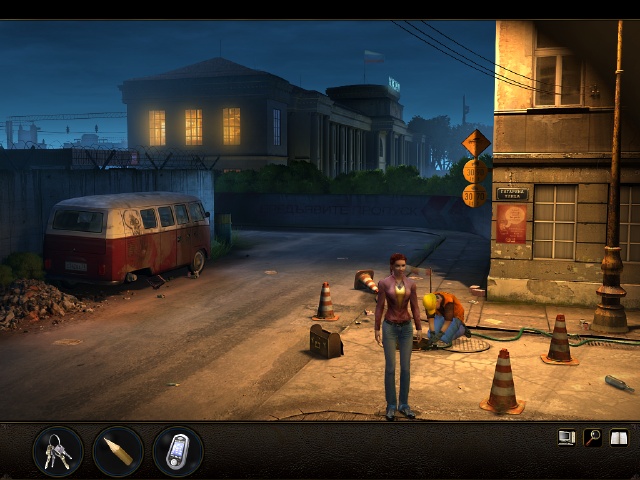|
Secret Files: Tunguska
 Ah, that's better. Had to turn off the overhead light before I could start writing. Atmoshpere. It's really important to get it right. Ah, that's better. Had to turn off the overhead light before I could start writing. Atmoshpere. It's really important to get it right.
When it comes down to it, it's actually quite difficult to get adventure games 'right'. I mean, there are only so many of us die-hard fans out there, and we're a picky bunch for the most part, oh yes. Got to have a good story, some engaging dialogue, and don't make the puzzles too easy/too hard. No mazes, no sliders, no music puzzles, please. And we'll have point-and-click if you can do that too, thanks. Well, Secret Files: Tunguska does... most of that.
In 1908, the earth had a close call with something in the remote Tunguska, Siberia region. As with all unexplained phenomena, theories abound for what caused the massive explosion that felled every tree for miles around the epicentre, running the gamut from: a meteor, a nuclear detonation, a crashed alien ship... take your pick. In Secret Files: Tunguska you assume the role of Nina, a resourceful young woman whose father has become swept up in some international intrigue surrounding a research station that was constructed on-site to study this mysterious event. By virtue of his involvement with earlier expeditions to the area, it would seem that he's attracted the attention of some people that may not have his best interests at heart. As the game begins his office has been ransacked and he's missing, possibly kidnapped. Nina must find him, but she will not be alone in her endeavours. She quickly enlists the aid of Max, an earnest but somewhat befuddled young colleague of her father's, as she begins a search that will take her far from home and the comforts of modern Berlin. Nina seems a bit spoilt, especially at first, and I suppose this is as much a coming of age tale as anything else.
The graphics in Secret Files: Tunguska are top notch, featuring incredibly detailed backgrounds. I can't think of any recent adventure game that could do better, with the possible exception of Keepsake. But for me what puts it a cut above its peers is a solid return to the very roots of adventuring: inventory based puzzles. As alluded to earlier, there are no timed sequences, no fighting, no sneaking, and also no conversation 'puzzles' that make you plod through every possible question until you reach the single, inevitable outcome. Instead, the designers were obviously thinking more along the lines of... the way McGyver might think. So be warned that if you don't like inventory based puzzles, then Secret Files: Tunguska will definitely not be your cup of tea. The puzzles run from the trivial to the quite difficult, but even the most difficult ones are solvable with a little out-of-the-box reasoning, and that old standby: trying every object on every other object. Overall, I thought the mix was very good. Challenging enough for us jaded types, but still accessible to beginners.
For the record, the game is completely mouse controlled. You right-click on an object to get a description, left-click to pick it up or use it with another object. There is a handy journal that receives entries as Nina reaches key milestones in the game. You'd be well advised to keep an eye on it, as it nicely fills in gaps that you might not otherwise glean from the narrative. And speaking of narrative, there are several rather long exposition sequences you will have to sit through as Nina and Max transition between major plot points. They would be similar in length to those found in The Longest Journey. I didn't find them too onerous, and in fact consider them a bit of a necessity unless a game is meant to be nothing more than a collection of puzzles. But I'm aware these long cut scenes can be a real turn-off for some of you out there.
 There are two levels of help in the game. The first level highlights all the hotspots and exits in a scene, and can be accessed from the menu, or by just holding down the spacebar. Heck, I don't even consider this cheating. It just avoids a lot of frustration that would otherwise be incurred hunting for hotspots. And some of them are a miniscule 3 or 4 pixels across! Moving forward, I hope to see more games including a system like this. Screens are getting larger all the time, and the graphics are getting more detailed. It's just not as easy to distinguish objects that you can interact with from the background anymore, like it was in the days when adventures were all 'cartoony'.
The second level of help is in the form of actual hints provided on the last page of Nina's journal. These are only given for the 3 or 4 abstract puzzles that crop up in the game. I had a look at one of them after I completed a puzzle, and it would indeed have given a nice push in the right direction had I become stuck, without providing an outright solution. There are two levels of help in the game. The first level highlights all the hotspots and exits in a scene, and can be accessed from the menu, or by just holding down the spacebar. Heck, I don't even consider this cheating. It just avoids a lot of frustration that would otherwise be incurred hunting for hotspots. And some of them are a miniscule 3 or 4 pixels across! Moving forward, I hope to see more games including a system like this. Screens are getting larger all the time, and the graphics are getting more detailed. It's just not as easy to distinguish objects that you can interact with from the background anymore, like it was in the days when adventures were all 'cartoony'.
The second level of help is in the form of actual hints provided on the last page of Nina's journal. These are only given for the 3 or 4 abstract puzzles that crop up in the game. I had a look at one of them after I completed a puzzle, and it would indeed have given a nice push in the right direction had I become stuck, without providing an outright solution.
Having played the German version of the demo (needless to say, with the help of many dialogue screenshots and the BabelFish translator, which was an adventure in itself), I found it unsettling that all the actors were speaking with American accents in the international version of the game. Maybe I'm just old, or maybe I watched too many formulaic post-WWII films with James Mason playing German officers. But I lived in Amsterdam for seven years and I know from firsthand experience that people from each European country speak English with a unique accent that is endemic to that country. So when supposedly native German speakers are spouting dialogue with accents and expressions straight out of California mall land, well, that's just not what I expect to hear. In any case, I seem to be of a minority opinion in this respect as I've not heard anyone else making an issue of this. Notwithstanding the point of accents, the standard of voice acting is good throughout, except for the voice of a Russian character named Sergej. That particular piece of voice 'acting' is just plain awful, in any language.
Another complaint is also related to the dialogue, and the visual depiction thereof. Even though every spoken word is captured in sub-titles, the translations to English are very awkward in many cases. A few such badly mangled phrases are actually puzzle clues, and... well, let's just say they could have done much better with a little more effort spent on this important aspect of bringing the game to a wider audience.
There is a fair dose of 'toilet' humour in the game (most of which I thought was completely unnecessary), some sexual innuendo, and a few instances of the 's' word. My copy of the game was rated for ages 12+, and I suppose that's par for the course nowadays. Naturally, your opinion on these matters may differ.
Lastly, players of the North American version of Secret Files: Tunguska will find it impossible to complete the game without applying a patch. There is a puzzle about halfway through that is otherwise unsolvable. But, wait for it... this patch weighs in at a staggering 240MB! However, the patch also supplies an alternate ending because the developers did listen to feedback from European players who thought the original ending cut scene left too many loose ends. I have to agree that it's much better with the new ending, which by itself brought the whole experience up a notch. Anyway, just search for "tunguska 1.02 update". A good few sites are hosting it. I'm not sure if it's being made available on CD, but that might be the best/only option for dial-up users.
 If you're seeking a plausible explanation of what happened in the Tunguska region all those years ago, you're probably not going to find it here. But what you will get is a game that is fun to play, has plenty of dramatic moments, and yet manages not to take itself too seriously. Inevitably, Secret Files: Tunguska will be compared to the likes of the Gabriel Knight and Broken Sword series' for the way it handles the relationship between Nina and Max, and also for the way they take turns solving the puzzles, even working one sequence together. In the end, I became more attached to Max's character. He had this really over the top way of describing even the most mundane object you could pick up, like: "Oh wow! It's a... hex nut. How cool is that!" I realise this faux drama was intentional (at least I hope it was). But it still had me rolling on the floor.
So if you enjoy inventory based adventures that occasionally have you combining the most unlikely objects, narrative that rolls along at a fairly brisk pace, sumptuous graphics, a good soundtrack, and humour that owes itself to some inventive language translation as much as anything else... then I would recommend giving Secret Files: Tunguska a go. I'll be looking forward to the sequel, which according to the ending credits is due out sometime in 2008. The credits also feature some amusing outtakes that were done with the in-game engine, so be sure to watch them all the way through.
See the metzomagic.com Secret Files: Tunguska walkthrough. If you're seeking a plausible explanation of what happened in the Tunguska region all those years ago, you're probably not going to find it here. But what you will get is a game that is fun to play, has plenty of dramatic moments, and yet manages not to take itself too seriously. Inevitably, Secret Files: Tunguska will be compared to the likes of the Gabriel Knight and Broken Sword series' for the way it handles the relationship between Nina and Max, and also for the way they take turns solving the puzzles, even working one sequence together. In the end, I became more attached to Max's character. He had this really over the top way of describing even the most mundane object you could pick up, like: "Oh wow! It's a... hex nut. How cool is that!" I realise this faux drama was intentional (at least I hope it was). But it still had me rolling on the floor.
So if you enjoy inventory based adventures that occasionally have you combining the most unlikely objects, narrative that rolls along at a fairly brisk pace, sumptuous graphics, a good soundtrack, and humour that owes itself to some inventive language translation as much as anything else... then I would recommend giving Secret Files: Tunguska a go. I'll be looking forward to the sequel, which according to the ending credits is due out sometime in 2008. The credits also feature some amusing outtakes that were done with the in-game engine, so be sure to watch them all the way through.
See the metzomagic.com Secret Files: Tunguska walkthrough.
Copyright © Steve Metzler 2006.
All rights reserved.
System Requirements:
Minimum: Windows 2000/XP, 128MB RAM, PII 500MHZ, 16MB DirectX 9 compatible graphics card, DirectX 9 compatible sound card, 2GB free disk space, DVD-ROM, mouse
Recommended: Windows XP, 256MB RAM, PIV 1GHZ, 64MB DirectX 9 compatible graphics card
|

